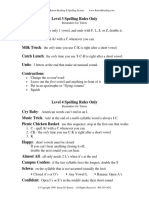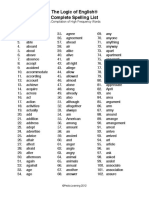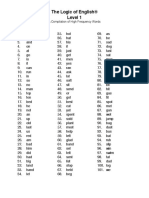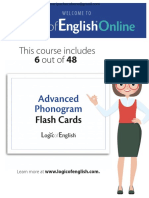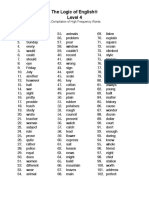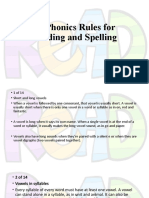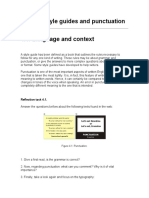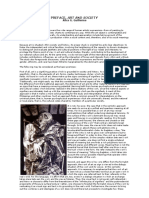Logic of English - Spelling Rules PDF
Uploaded by
Ravinder KumarLogic of English - Spelling Rules PDF
Uploaded by
Ravinder Kumar4/2/2015
LogicofEnglishSpellingRules
Phonogram List
Spelling Rules
Spelling Lists
Research
Spelling Rules
The 31 spelling rules taught in Logic of English curriculum.
Rule 1
C always softens to /s/ when followed by E, I, or Y.
Otherwise, C says /k/.
Rule 2
G may soften to /j/ only when followed by E, I, or Y.
Otherwise, G says /g/.
Rule 3
English words do not end in I, U, V, or J.
Rule 4
A E O U usually say their names at the end of a syllable.
Rule 5
I and Y may say // or // at the end of a syllable.
Rule 6
When a one-syllable word ends in a single vowel Y, it says //.
Rule 7
Y says // only at the end of a multisyllable base word.
I says // at the end of a syllable that is followed by a vowel and at the end of foreign w
Rule 8
I and O may say // and // when followed by two consonants.
Rule 9
AY usually spells the sound // at the end of a base word.
Rule 10
When a word ends with the phonogram A, it says //.
A may also say // after a W or before an L.
Rule 11
Q always needs a U; therefore, U is not a vowel here.
Rule 12
Silent Final E Rules
12.1 The vowel says its name because of the E.
12.2 English words do not end in V or U.
12.3 The C says /s/ and the G says /j/ because of the E.
12.4 Every syllable must have a written vowel.
https://www.logicofenglish.com/resources/spellingrules
1/3
4/2/2015
LogicofEnglishSpellingRules
12.5 Add an E to keep singular words that end in the letter S from looking plural.
12.6 Add an E to make the word look bigger.
12.7 TH says its voiced sound /TH/ because of the E.
12.8 Add an E to clarify meaning.
12.9 Unseen reason.
Rule 13
Drop the silent final E when adding a vowel suffix only if it is allowed by other spelling
Rule 14
Double the last consonant when adding a vowel suffix to words ending in one vowel f
consonant only if the syllable before the suffix is accented.*
*This is always true for one-syllable words.
Rule 15
Single vowel Y changes to I when adding any ending, unless the ending begins with I.
Rule 16
Two Is cannot be next to one another in English words.
Rule 17
TI, CI, and SI are used only at the beginning of any syllable after the first one.
Rule 18
SH spells /sh/ at the beginning of a base word and at the end of the syllable. SH never
beginning of any syllable after the first one, except for the ending -ship.
Rule 19
To make a verb past tense, add the ending -ED unless it is an irregular verb.
Rule 20
-ED, past tense ending, forms another syllable when the base word ends in /d/ or /t/.
Otherwise, -ED says /d/ or /t/.
Rule 21
To make a noun plural, add the ending -S, unless the word hisses or changes; then add
Occasional nouns have no change or an irregular spelling.
Rule 22
To make a verb 3rd person singular, add the ending -S, unless the word hisses or chan
four verbs are irregular.
Rule 23
Al- is a prefix written with one L when preceding another syllable.
Rule 24
-Ful is a suffix written with one L when added to another syllable.
Rule 25
DGE is used only after a single vowel which says its short (first) sound.
Rule 26
CK is used only after a single vowel which says its short (first) sound.
Rule 27
TCH is used only after a single vowel which does not say its name.
Rule 28
AUGH, EIGH, IGH, OUGH. Phonograms ending in GH are used only at the end of a base
https://www.logicofenglish.com/resources/spellingrules
2/3
4/2/2015
LogicofEnglishSpellingRules
letter T.
The GH is either silent or pronounced /f/.
Rule 29
Z, never S, spells /z/ at the beginning of a base word.
Rule 30
We often double F, L, and S after a single vowel at the end of a base word. Occasionall
doubled.
Rule 31
Any vowel may say one of the schwa sounds, // or //, in an unaccented syllable or un
also say // in an accented syllable next to a W, TH, M, N, or V.
2011-2015 Pedia Learning Inc. Logic of English is a registered trademark of Pedia Learning Inc.
https://www.logicofenglish.com/resources/spellingrules
3/3
You might also like
- Ultimate Phonics Word Lists and Sentences100% (22)Ultimate Phonics Word Lists and Sentences587 pages
- Phonic Stories For Older Learners Download PDF82% (11)Phonic Stories For Older Learners Download PDF98 pages
- Phonics Lessons - A Complete 61 Lessons Course For Teaching Beginning Readers To Read and Spell100% (17)Phonics Lessons - A Complete 61 Lessons Course For Teaching Beginning Readers To Read and Spell193 pages
- Worksheets - Syllables and Affixes - 2nd Edition100% (4)Worksheets - Syllables and Affixes - 2nd Edition230 pages
- Free Book To Learning Benin Language PDF - Google SearchNo ratings yetFree Book To Learning Benin Language PDF - Google Search5 pages
- Guide To Phonics Pathways (10th Ed.) & Reading Pathways75% (4)Guide To Phonics Pathways (10th Ed.) & Reading Pathways20 pages
- DSE Paper 3 Part A - Skills and RemindersNo ratings yetDSE Paper 3 Part A - Skills and Reminders3 pages
- Logic of English - Tips For Dividing A Word Into SyllablesNo ratings yetLogic of English - Tips For Dividing A Word Into Syllables2 pages
- Logic of English High Frequency Word List Level 1No ratings yetLogic of English High Frequency Word List Level 11 page
- Spelling Program Excellent For All Planning Save For Next Year100% (5)Spelling Program Excellent For All Planning Save For Next Year232 pages
- Logic of English High Frequency Word List Level 4No ratings yetLogic of English High Frequency Word List Level 44 pages
- 14 Phonics Rules For Reading and SpellingNo ratings yet14 Phonics Rules For Reading and Spelling15 pages
- Teach Reading with Orton-Gillingham: Early Reading Skills: A Companion Guide with Dictation Activities, Decodable Passages, and Other Supplemental Materials for Struggling Readers and Students with DyslexiaFrom EverandTeach Reading with Orton-Gillingham: Early Reading Skills: A Companion Guide with Dictation Activities, Decodable Passages, and Other Supplemental Materials for Struggling Readers and Students with DyslexiaNo ratings yet
- Unit 4 .-Style Guides and Punctuation 4.1. Language and ContextNo ratings yetUnit 4 .-Style Guides and Punctuation 4.1. Language and Context33 pages
- Narrative Report On Elln Indorsement Letter Inset 2021No ratings yetNarrative Report On Elln Indorsement Letter Inset 20213 pages
- .Archivetempgraded Readers Catalog - Final (Low) - 0331No ratings yet.Archivetempgraded Readers Catalog - Final (Low) - 033148 pages
- 7 - Higher Order Cognitive Skills in Filipino - Towards Measurable Criteria PDFNo ratings yet7 - Higher Order Cognitive Skills in Filipino - Towards Measurable Criteria PDF13 pages
- Impairment of Processing: Keywords: Psycholinguistics, Impairment, LanguageNo ratings yetImpairment of Processing: Keywords: Psycholinguistics, Impairment, Language9 pages
- Possessive Adjectives and Pronouns Senor Jordan Version of The LessonNo ratings yetPossessive Adjectives and Pronouns Senor Jordan Version of The Lesson133 pages
- Free 15-minute English test _ EF SET Quick CheckNo ratings yetFree 15-minute English test _ EF SET Quick Check3 pages
- Grade 7 - Assessment Schedule for Term 2No ratings yetGrade 7 - Assessment Schedule for Term 23 pages
- Hengki Agus Rifa'i On LinkedIn: #Ielts #No ratings yetHengki Agus Rifa'i On LinkedIn: #Ielts #2 pages
- Investigating The English Language Needs of Petroleum Engineering Students at Hadramout University of Science and TechnologyNo ratings yetInvestigating The English Language Needs of Petroleum Engineering Students at Hadramout University of Science and Technology31 pages





















